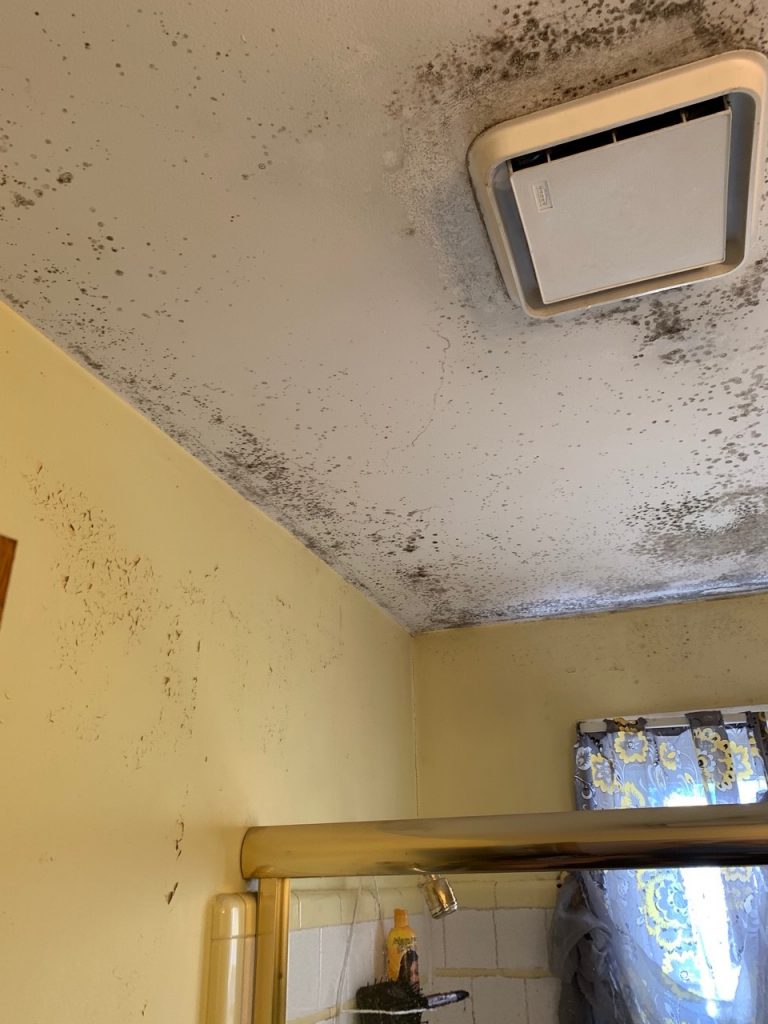When people find mold in their home, they tend to ask the same question: “is it toxic?” The answer is complicated. A quick look at common search terms for mold highlights a common assumption made by the general public.
One of the most common search terms for mold is “black mold.” This leads many people to believe that the color of the mold is a good indicator of its toxicity. Unfortunately, this is not the case. Toxic molds span a wide range of colors, so this is not an effective strategy for determining how you or your family will react to the mold. Mold cannot be identified visually. In order to identify mold a sample must be collected and sent off to a lab. This can be an expensive and time consuming process.

Is it worth it?
While certain types of mold produce mycotoxins that can directly affect human health, all molds act as irritants in our bodies and have the potential to cause our immune systems to overreact. It is for this reason that we recommend the removal of any visible mold, as neither of these outcomes is desirable.
That said, it is helpful to understand the properties of different types of molds to get a broader understanding of how they can affect our health.
The Most Dangerous Molds
There are five categories of toxic mold: Fusarium, Stachybotrys (black mold), Aspergillus, Cladosporium and Penicillium. Each of these categories include many different mold species and have a variety of harmful characteristics. The symptoms from these molds can be fatal and all five can be found indoors in homes and buildings, growing in hidden areas like the attic, basement, and crawlspaces.
Penicillium
Penicillium consists of about 200 different species of molds commonly found in the soil and air. The main purpose of these molds is to cause foods and other perishable items to spoil, indicating there are high moisture levels in the area. When growing in your home, they will attach themselves to damp porous materials, including carpets, floors, and wallpaper. These molds range in color from blue, yellow, green, and white.
Common symptoms of Penicillium exposure include infections of the lungs, liver, and kidneys, asthma and nail fungus.
Fusarium
Even at lower temperatures, fusarium molds can develop and spread, most often found on water-damaged fabrics and furnishings. Long-term exposure can result in asthma and severe respiratory conditions. This mold is often orange in color.
Fusarium has also been known to cause gastrointestinal issues as well as illnesses that affect the female reproductive system.
Aspergillus
Aspergillus consists of almost 200 species. This mold is often yellow-greenish in color and usually found indoors. Ignoring its presence can result in respiratory infections and cause lung inflammation, a condition called hypersensitivity pneumonitis.
Toxic molds also produce chemicals while growing that are considered to be toxic. They are given the label of “toxic mold” as they have been considered to have profound effects on humans.
Cladosporium
Cladosporium is quite common and is considered to be one of the most dangerous types of mold. It grows gray, black, brown, or green in color and consists of about 40 different species. It commonly grows on wet porous materials like carpets, drywall, painted walls, wallpaper, and furnishings. Chronic illnesses occurring from the exposure to Cladosporium include pulmonary edema and emphysema.
Stachybotrys
Stachybotrys is an extremely dangerous type of mold, also known as black mold. Species falling into this category will produce mycotoxins when disturbed, resulting in a number of serious illnesses and infections.
Stachybotrys usually grows on porous materials containing cellulose that have been damp for a while, including wood, gypsum board, ceiling tile, and other porous materials.
This mold has also been linked to severe sickness within babies. With compromised immune systems, infants, young children, and the elderly are most susceptible to illness when exposed to this type of mold. Many symptoms of Stachybotrys include but are not limited to the following:
- Aches and pains
- Chronic fatigue
- Sore throat
- Respiratory issues
- Eye irritation
- Coughing
- Nasal and sinus congestion
- Central nervous system issues

What to Do When Finding Toxic Mold
While mold is known to be dangerous to humans, especially with the five most dangerous categories listed above, it is a natural presence in the air. Small amounts of spores in the air won’t cause any problems, but the presence of moisture and humidity will allow them to grow within affected areas.
As soon as you find any type of mold growing in your home or building, it’s crucial to maintain your distance and call a mold removal professional. While you’re awaiting service, be sure to wear protective equipment, including a mask, eyewear and goggles, and repair any moisture source allowing the mold to spread. It’s also recommended to turn on the air conditioner to allow air to flow throughout the living space. To prevent additional mold from colonizing, the moisture levels in the home or building should stay at or below 60 percent relative humidity.
While you can take steps to prevent it from spreading, never try to remove mold yourself. Doing so is not only dangerous and will cause serious illness, it also will disperse additional spores into breathing air and make matters worse. If any spores are left behind from the cleaning job, the mold will just grow back and become worse.
Professional Mold Remediation
When working with a mold remediation professional, they will first set up a containment chamber around the affected area to prevent cross contamination. The technicians will also be trained, IICRC-certified, and experienced in removing all types of mold from all areas of homes and buildings. Using professional products and safety equipment, they will remove all mold at the source to prevent it from returning again in the future.
For water damage within the affected area, they can remove soiled porous material and dry out the space to return it to safe and dry conditions. This will prevent any mold from re-colonizing.
Contact ServiceMaster NCR today if you suspect mold or water damage within your home.













